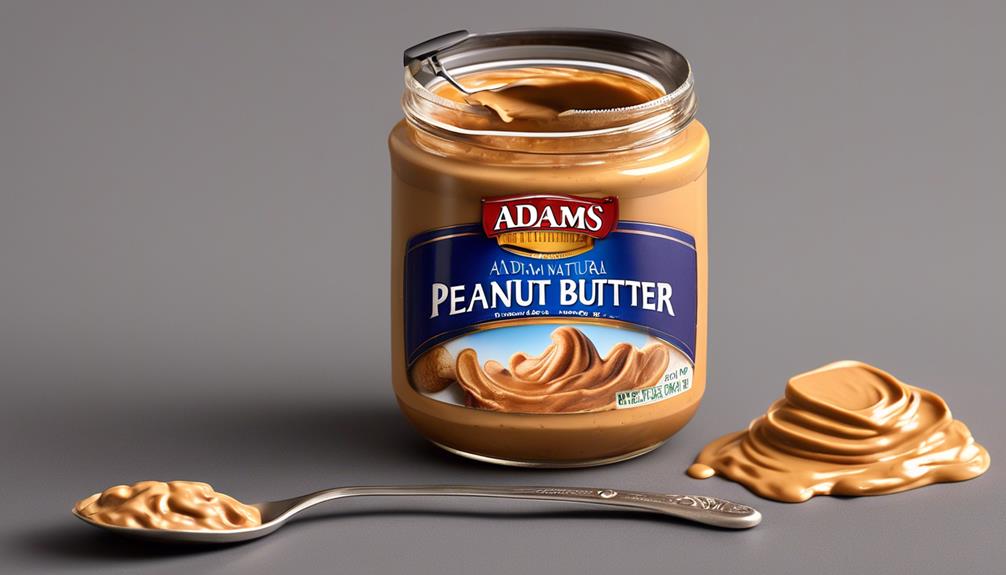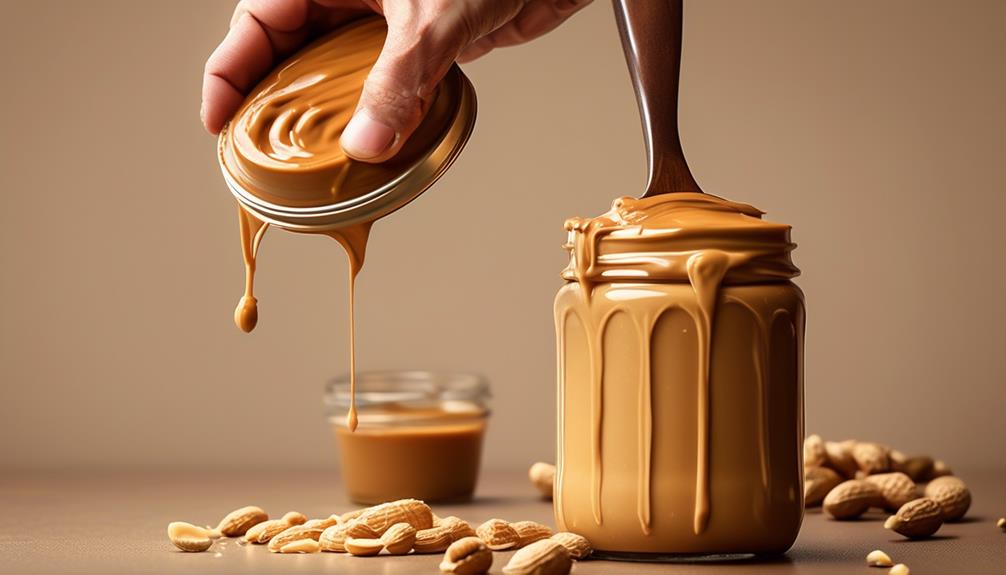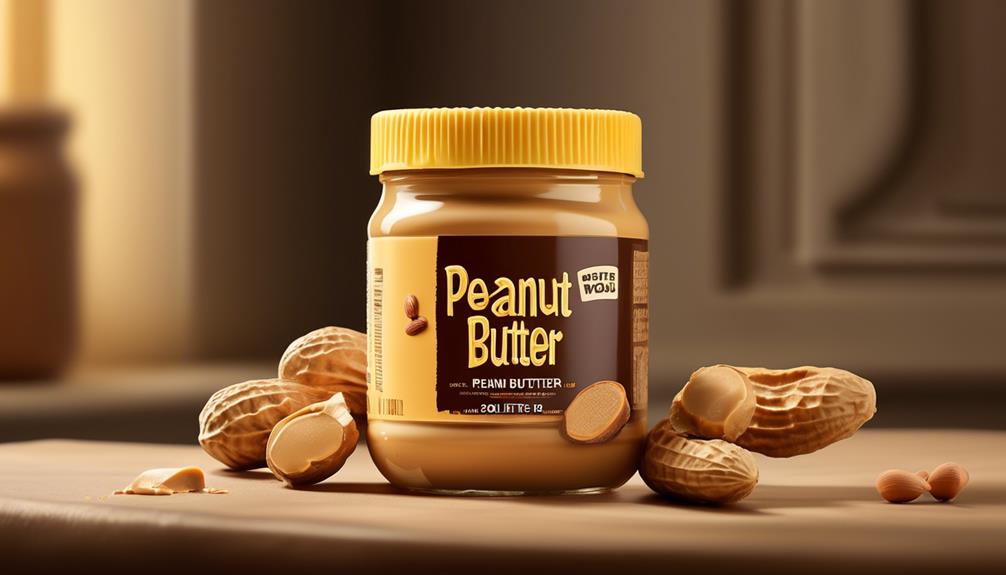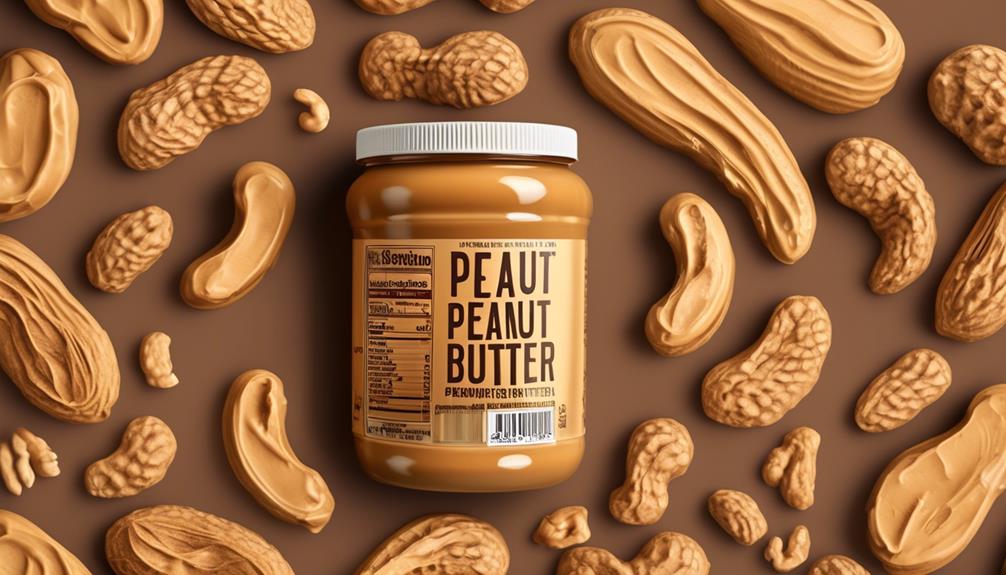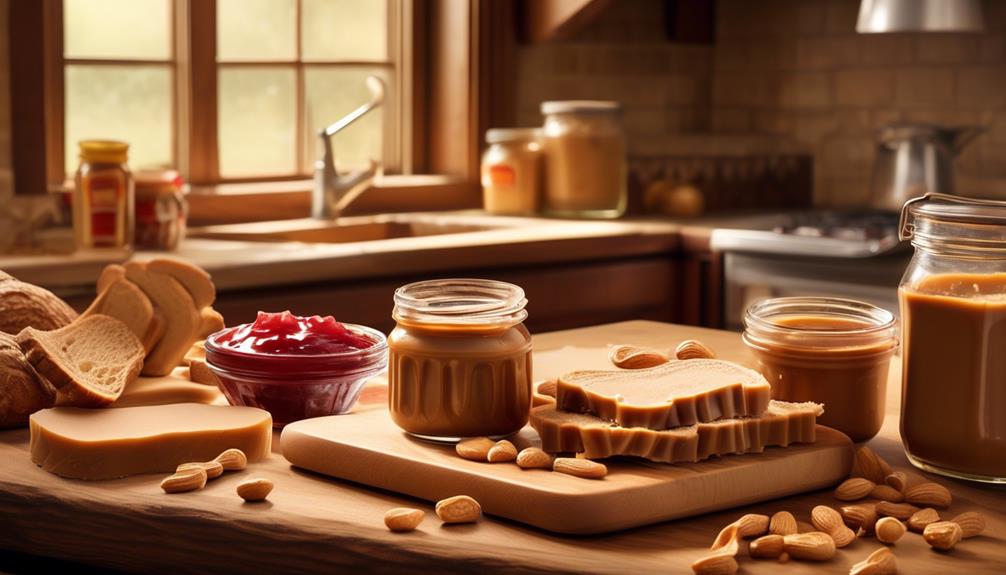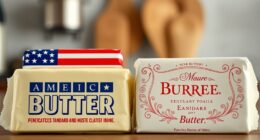Just opened a jar of Adams Natural Peanut Butter and curious about its shelf life?
Well, I recently found myself in the same situation and was surprised to learn that properly stored, opened Adams Natural Peanut Butter can maintain its quality for quite a while.
But there's more to it than just tossing it in the fridge. If you're curious about the specifics and want to ensure that your peanut butter stays delicious for as long as possible, keep reading to discover the factors that influence its longevity and the best practices for extending its shelf life.
Key Takeaways
- Unopened Adams Natural Peanut Butter has a shelf life of 3-4 weeks at room temperature.
- Refrigerating opened Adams Natural Peanut Butter extends its shelf life to 6 months.
- Tightly covered natural peanut butter can be stored at room temperature for about a month.
- Regularly check for signs of spoilage such as odor, mold, changes in appearance, and flavor to ensure safety for consumption.
Shelf Life of Adams Natural Peanut Butter
When properly stored, natural peanut butter, such as Adams Natural Peanut Butter, has a shelf life of 3-4 weeks if unopened and can last up to 6 months when refrigerated after opening. The key to preserving the quality of natural peanut butter is to minimize oil separation and maintain freshness.
At room temperature, unopened Adams Natural Peanut Butter can last approximately 3-4 weeks. Once opened, it's crucial to refrigerate the product, which extends its shelf life to around 6 months. However, if tightly covered, natural peanut butter can be stored at room temperature for about a month without compromising its integrity.
It's important to keep an eye out for any signs of spoilage, such as an off odor, flavor, appearance, mold, or rancid taste, as these indicate that the product has gone bad. By following these storage guidelines and being attentive to changes in the product, consumers can maximize the shelf life of Adams Natural Peanut Butter and enjoy its freshness for an extended period.
Recommended Storage Practices

We recommend storing natural peanut butter in a cool, dark place like the pantry to maintain its quality.
Once opened, transfer the jar to the refrigerator to prolong its shelf life.
It's important to keep the jar tightly sealed to prevent air and moisture exposure, ensuring the peanut butter stays fresh for an extended period.
Proper Storage Methods
To ensure the longevity and quality of Adams Natural Peanut Butter, proper storage methods are essential. Here are some tips to help you keep your peanut butter fresh and delicious:
- Keep it Sealed: After each use, make sure to tightly seal the jar to prevent exposure to air, which can cause the oil in the natural peanut butter to go rancid.
- Use a clean, dry spoon to scoop out the peanut butter to avoid introducing any moisture into the jar.
- Store the jar in a cool, dark place away from direct sunlight and heat sources.
Shelf Life After Opening
After opening, it's recommended to refrigerate natural peanut butter to preserve its quality and freshness. This practice helps to extend the shelf life of natural peanut butter, preventing oil rancidity and maintaining its spreadability. When stored in the refrigerator in a tightly covered container, opened natural peanut butter can last up to 6 months, ensuring that it remains safe for consumption.
It's crucial to pay attention to any changes in odor, flavor, appearance, or the presence of mold, as these can indicate bacterial growth and spoilage. Regularly checking the expiration date and adhering to proper storage methods will help maintain the quality and safety of natural peanut butter for an extended period after opening.
Signs of Spoilage in Opened Peanut Butter

Upon opening a container of natural peanut butter, it's essential to inspect for any signs of spoilage, such as off odors, mold growth, or changes in color or texture, to ensure its safety for consumption.
Here are some key indicators to look out for:
- Smell: Give the peanut butter a good sniff. If it smells off or rancid, it's best to discard it as this could indicate spoilage.
- *Personal note: We've all experienced the unpleasant surprise of spoiled food, so trust your nose on this one!*
- Visual Changes: Keep an eye out for any mold growth or changes in color and texture. Darkening or dryness can be signs that the peanut butter has gone bad.
- *Personal note: No one wants to discover mold in their peanut butter, so a quick visual check can save you from an unpleasant experience.*
Properly sealing the container after each use and storing it away from direct sunlight can help maintain the quality of Adams natural peanut butter.
Always remember to give it a good inspection before enjoying that delicious, creamy goodness to ensure a safe and enjoyable snacking experience.
Factors Affecting Longevity After Opening

Proper storage conditions impact the longevity of opened natural peanut butter. A cool, dry place is optimal for storing the product. This helps to maintain its freshness and quality. Additionally, oil separation serves as an indication marker for the freshness of the peanut butter. Understanding these factors is crucial for maintaining the shelf life of Adams Natural Peanut Butter after opening.
Storage Conditions Impact
When storing Adams Peanut Butter, it's suitable to keep it at room temperature or in a cupboard, as refrigeration, while able to slow down oil separation, isn't necessary. Here's how storage conditions impact the longevity of your peanut butter:
- Room Temperature vs. Refrigeration: Storing at room temperature maintains a creamy texture, while refrigeration can harden the peanut butter, making it less spreadable.
- Oil Separation: Natural peanut butter may experience oil separation, but storing it at room temperature allows for easier stirring and a more consistent texture.
- Preservatives: Some commercial peanut butters contain preservatives like sodium benzoate, which can extend shelf life and delay oil separation.
Understanding these storage nuances can help ensure that your peanut butter remains fresh and delicious until the last spoonful at the bottom of the jar.
Oil Separation Indication Marker
After opening, natural peanut butter can maintain its freshness and quality for up to 6 months when refrigerated, with tightly covering and periodic stirring serving as effective methods to address oil separation.
| Oil Separation Indication Marker | Description |
|---|---|
| Appearance | Oil pooling on the surface is a natural occurrence in natural peanut butter. Stir the oil back into the peanut butter to restore its creamy consistency. |
| Jar | Store the jar upright to minimize oil separation. This helps evenly distribute the natural oils throughout the peanut butter. |
| Hydrogenated Oils | Avoid peanut butter with added hydrogenated oils, as they can affect the natural oil separation process and alter the product's longevity. |
These markers play a crucial role in maintaining the quality of natural peanut butter after opening. By understanding and addressing oil separation, consumers can maximize the shelf life and enjoy the product at its best.
Extending the Freshness of Opened Peanut Butter

Refrigerating opened natural peanut butter can effectively extend its freshness for up to 6 months, as the cold temperature slows the rate at which the oils in the peanut butter go rancid. To maintain the quality and freshness of natural peanut butter, consider the following:
- Tightly Sealed Container: Transfer the peanut butter into a tightly sealed container before refrigerating. This helps prevent it from absorbing odors from other foods in the fridge and maintains its original flavor.
- Proper Storage: Store the tightly sealed container of natural peanut butter in the coldest part of the refrigerator, such as the back of the bottom shelf. This ensures a consistent low temperature, which is crucial for slowing down the oxidation process and extending the freshness of the peanut butter.
Disposal Guidelines for Expired Peanut Butter

To ensure safe consumption and prevent potential health risks, it's essential to discard expired natural peanut butter exhibiting off odors, strange appearance, mold, or a rancid flavor. When disposing of expired peanut butter, it's important to consider the potential risks associated with consuming spoiled products.
Spoiled peanut butter can harbor harmful bacteria, leading to food poisoning, allergic reactions, digestive issues, and overall health implications. Proper disposal of rancid peanut butter is crucial in preventing these potential hazards.
When encountering any of the aforementioned signs of spoilage, it's best to immediately discard the product to avoid any health risks. This can be done by sealing the expired peanut butter in a bag and placing it in the trash.
It's also important to thoroughly clean the area where the peanut butter was stored to prevent any potential cross-contamination. By following proper disposal guidelines for expired peanut butter, individuals can effectively mitigate the risks associated with consuming spoiled products.
Frequently Asked Questions
Does Adams Natural Peanut Butter Go Bad?
Adams Natural Peanut Butter can go bad if not stored properly. Signs of spoilage include off odor, flavor, appearance, mold, or oil separation.
Once opened, it can last up to 6 months in the refrigerator. Proper storage and handling can extend its shelf life, and refrigeration can prevent oil rancidity.
It's important to discard it if any of the mentioned signs are observed to ensure safety and quality.
How Long Is Natural Peanut Butter Good for After Opening?
After opening, natural peanut butter is good for up to 6 months when refrigerated. This helps maintain its freshness and quality.
At room temperature, it can last about one month, but refrigeration extends its shelf life.
It's important to stir any separated oil back into the peanut butter.
If it develops an off odor, flavor, appearance, or mold, it should be discarded.
Proper storage and handling are essential to maximize its shelf life.
Should I Refrigerate Adams Peanut Butter After Opening?
We should definitely refrigerate Adams peanut butter after opening. Refrigeration helps maintain its freshness and quality, extending its shelf life for up to 6 months.
When sealed and refrigerated, it can last about one month at room temperature. Refrigeration slows down the rate at which the oils in natural peanut butter can go rancid, ensuring it stays safe to eat.
How Can You Tell if Peanut Butter Has Gone Bad?
We can tell if peanut butter has gone bad by checking for signs of spoilage like a rancid smell, off taste, or mold growth.
It's essential to inspect the texture for any unusual changes, such as oil separation or discoloration.
If the peanut butter exhibits any of these indicators, it's best to discard it for safety reasons.
Proper storage and regular inspection help maintain the quality of the product.
Conclusion
In conclusion, Adams Natural Peanut Butter can last up to 6 months in the refrigerator after opening, but proper storage and handling are crucial. By tightly covering and refrigerating the peanut butter, its freshness and quality can be maintained.
Remember, a little extra effort in storage goes a long way in keeping your peanut butter as fresh as a daisy.
